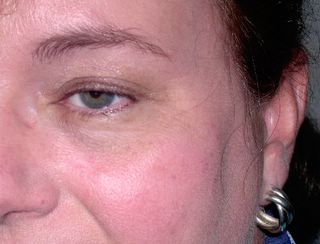Woman Survives Skin Cancer
... But Warns Against Exposure to Sun
By Angela Perez - June 3rd, 2005
When Janet Capehart was told by her doctor that she had skin cancer, she was shocked. “I had this little tiny dry patch on my cheek for about six months,” said Capehart, a pediatric asthma nurse for Bertie Memorial Hospital in Windsor. “I really didn’t think much of it except that I was aggravated that it wouldn’t go away.”
Capehart, a native of Bertie County, said that she did begin to get a little worried when the spot began to bleed just the tiniest bit when she dried her skin with a towel after washing her face. At that point, she decided it was time to visit a dermatologist.
Her physician informed her that she had basal cell carcinoma, one of the most common of all types of skin cancers and one of the most curable. The Skin Cancer Foundation estimates that a total of 800,000 cases are diagnosed each year. Although the doctor chastised Capehart for waiting for so long to have the spot examined, he explained that the basal cell had not spread or grown too deeply into her skin to cause cosmetic disfigurement or spread to her nerves her eyes . The procedure to have it removed took only 45 minutes and was performed in the doctor’s office.
Capehart now has a very faint, almost unnoticeable one-inch scar on her left cheek about 2 inches below her eye that reminds her every day to pay close attention to changes on her skin. She now uses sunscreen whenever she goes outside and goes to her doctor for follow-up visits every six months. The possibility of recurrence or the development of new tumors is a definite possibility, according to the American Academy of Dermatology (AAD).

Janet Capehart's Scar Is Barely Noticeable.
Capehart said that her doctor told her of a 32-year old female patient who was dying from melanoma probably caused from too much exposure in a tanning bed. “He told me that she had not paid attention to the symptoms and warned me that even though I didn’t have this type of skin cancer, I must always pay attention to changes on my skin,” she said.
What are the symptoms of basal cell carcinoma?
The five most typical characteristics, according to the Skin Cancer Foundation, are:
-Open Sore that bleeds, oozes, or crusts and remains open for three or more weeks. A persistent, non-healing sore is a very common sign of an early basal cell carcinoma.
-A Reddish Patch or irritated area, frequently occurring on the chest, shoulders, arms, or legs. Sometimes the patch crusts. It may also itch or hurt. At other times, it persists with no noticeable discomfort.
-A Shiny Bump or nodule, that is pearly or translucent and is often pink, red, or white. The bump can also be tan, black, or brown, especially in dark-haired people, and can be confused with a mole.
-A Pink Growth with a slightly elevated rolled border and a crusted indentation in the center. As the growth slowly enlarges, tiny blood vessels may develop on the surface.
-A Scar-like Area which is white, yellow or waxy, and often has poorly defined borders. The skin itself appears shiny and taut. Although a less frequent sign, it can indicate the presence of an aggressive tumor.
Anyone displaying these symptoms should see a physician immediately.
“I asked my doctor how could I have gotten this,” said Capehart, a middle-aged mother of three. “I’m never in the sun.” Her physician told her that the causes are primarily attributed to long-term exposure to sun and typically occur on the body parts that are most frequently exposed -- the face, ears, neck, scalp, shoulders, and back. At the highest risk are those with fair skin, light hair, and blue, green, or gray eyes. Her doctor also informed her that the cancer could be the result of sun-damage caused from childhood or early adulthood or even daily exposure over time.
Capehart said that while she is fair-skinned, she never thought that the kind of exposure that comes with simply going to work and driving in her car would add up to skin cancer. “I now tell my daughter, who is a true-blue sun worshipper, to stop laying out and protect her skin. I hope my experience teachers her the dangers of sun exposure.”
On Saturday, June 11, free skin cancer screenings will be held at Cashie Medical Center (located inside of Bertie Memorial Hospital) from 9 a.m. to noon. No appointments are necessary. For more information, call 794-6775.
Angela Perez
Bertie Memorial Hospital
Marketing/Community Relations Coordinator


0 Comments:
Post a Comment
<< Home